Fiche Personne
Cinéma/TV
Média
 ©
©
Smaïl Lakhdar-Hamina
Réalisateur/trice, Scénariste, Directeur/trice de la photo
(Homme)
Algérie
 ©
©
Français
Smaïl Lakhdar-Hamina (إسماعيل لخضر حامينا), né en 1943 à M'Sila en Algérie et décédé le 14 décembre 2021, à l'âge de 78 ans à Alger, est un directeur de la photographie et réalisateur algérien.
Né en 1943 à M’Sila, Smaïl Lakhdar-Hamina grandit dans une famille marquée par le cinéma : il est le frère du célèbre réalisateur Mohammed Lakhdar-Hamina, Palme d’or à Cannes en 1975 pour le film Chronique Des Années De Braise. Cette proximité familiale avec le monde du cinéma l’oriente très tôt vers une carrière technique, se spécialisant dans la direction de la photographie.
Smaïl Lakhdar-Hamina débute sa carrière dans les années 1960, période charnière pour le cinéma algérien naissant. Il s’impose rapidement comme un chef opérateur incontournable, participant à la création de l’esthétique visuelle de nombreux films algériens emblématiques. Parmi les œuvres majeures auxquelles il a collaboré, on compte : Hassan Terro (1968) de Mohamed Lakhdar-Hamina, une comédie dramatique devenue culte. Omar Gatlato (1976) de Merzak Allouache, film pionnier du renouveau cinématographique algérien. Les Folles Années Du Twist (1983) de Mohamed Zemmouri, chronique sociale sur fond de musique et de jeunesse. Camp de Thiaroye (1988), coréalisé par Ousmane Sembène et Thierno Faty Sow, qui traite du retour tragique des tirailleurs sénégalais après la Seconde Guerre mondiale. Smaïl Lakhdar-Hamina a également travaillé sur de nombreux autres films notables, tels que L’homme qui regardait les fenêtres (1978), Le Refus (1982), Rose des Sables (1989), Errances (1993), Fatima et la mer (1995), L’envers du miroir (2007) et Créneaux (2009).
Sa carrière s’étend sur plus de quatre décennies, durant lesquelles il a su s’adapter à l’évolution des techniques et des styles cinématographiques. Reconnu pour la qualité de sa lumière et son sens du cadre, Smaïl Lakhdar-Hamina a contribué à façonner l’image du cinéma algérien, apportant une touche réaliste et poétique à ses collaborations. Son travail a permis de mettre en valeur les paysages, les visages et les atmosphères propres à l’Algérie et à l’Afrique du Nord, participant à l’essor d’un cinéma national authentique et engagé.
Smaïl Lakhdar-Hamina est décédé le 14 décembre 2021 à Alger, à l’âge de 78 ans. Il laisse derrière lui une œuvre dense et respectée, ayant marqué plusieurs générations de cinéastes et de spectateurs. Il a été inhumé au cimetière de Ben Aknoun à Alger. Sa carrière reste un modèle pour les jeunes directeurs de la photographie du Maghreb, et son nom demeure associé à l’âge d’or du cinéma algérien.
https://www.imdb.com/fr/name/nm0482229/
Né en 1943 à M’Sila, Smaïl Lakhdar-Hamina grandit dans une famille marquée par le cinéma : il est le frère du célèbre réalisateur Mohammed Lakhdar-Hamina, Palme d’or à Cannes en 1975 pour le film Chronique Des Années De Braise. Cette proximité familiale avec le monde du cinéma l’oriente très tôt vers une carrière technique, se spécialisant dans la direction de la photographie.
Smaïl Lakhdar-Hamina débute sa carrière dans les années 1960, période charnière pour le cinéma algérien naissant. Il s’impose rapidement comme un chef opérateur incontournable, participant à la création de l’esthétique visuelle de nombreux films algériens emblématiques. Parmi les œuvres majeures auxquelles il a collaboré, on compte : Hassan Terro (1968) de Mohamed Lakhdar-Hamina, une comédie dramatique devenue culte. Omar Gatlato (1976) de Merzak Allouache, film pionnier du renouveau cinématographique algérien. Les Folles Années Du Twist (1983) de Mohamed Zemmouri, chronique sociale sur fond de musique et de jeunesse. Camp de Thiaroye (1988), coréalisé par Ousmane Sembène et Thierno Faty Sow, qui traite du retour tragique des tirailleurs sénégalais après la Seconde Guerre mondiale. Smaïl Lakhdar-Hamina a également travaillé sur de nombreux autres films notables, tels que L’homme qui regardait les fenêtres (1978), Le Refus (1982), Rose des Sables (1989), Errances (1993), Fatima et la mer (1995), L’envers du miroir (2007) et Créneaux (2009).
Sa carrière s’étend sur plus de quatre décennies, durant lesquelles il a su s’adapter à l’évolution des techniques et des styles cinématographiques. Reconnu pour la qualité de sa lumière et son sens du cadre, Smaïl Lakhdar-Hamina a contribué à façonner l’image du cinéma algérien, apportant une touche réaliste et poétique à ses collaborations. Son travail a permis de mettre en valeur les paysages, les visages et les atmosphères propres à l’Algérie et à l’Afrique du Nord, participant à l’essor d’un cinéma national authentique et engagé.
Smaïl Lakhdar-Hamina est décédé le 14 décembre 2021 à Alger, à l’âge de 78 ans. Il laisse derrière lui une œuvre dense et respectée, ayant marqué plusieurs générations de cinéastes et de spectateurs. Il a été inhumé au cimetière de Ben Aknoun à Alger. Sa carrière reste un modèle pour les jeunes directeurs de la photographie du Maghreb, et son nom demeure associé à l’âge d’or du cinéma algérien.
https://www.imdb.com/fr/name/nm0482229/
English
Smaïl Lakhdar-Hamina (إسماعيل لخضر حامينا), born in 1943 in M'Sila, Algeria, and died on December 14, 2021, at the age of 78, in Algiers, is an Algerian cinematographer and director.
Born in 1943 in M'Sila, Smaïl Lakhdar-Hamina grew up in a family steeped in cinematography: he was the brother of the renowned director Mohammed Lakhdar-Hamina, who won the Palme d'Or at Cannes in 1975 for the film "Chronique Des Années de Braise." This family connection to the world of cinema led him early on toward a technical career, specializing in cinematography.
Smaïl Lakhdar-Hamina began his career in the 1960s, a pivotal period for the nascent Algerian cinema. He quickly established himself as a key cinematographer, helping to create the visual aesthetic of many iconic Algerian films. Among the major works he collaborated on are: Hassan Terro (1968) by Mohamed Lakhdar-Hamina, a comedy-drama that has become a cult classic. Omar Gatlato (1976) by Merzak Allouache, a pioneering film in the Algerian cinematic revival. Les Folles Années Du Twist (1983) by Mohamed Zemmouri, a social chronicle set against a backdrop of music and youth. Camp de Thiaroye (1988), co-directed by Ousmane Sembène and Thierno Faty Sow, which deals with the tragic return of Senegalese riflemen after the Second World War. Smaïl Lakhdar-Hamina also worked on numerous other notable films, such as The Man Who Looked at the Windows (1978), The Refusal (1982), Rose of the Sands (1989), Wanderings (1993), Fatima and the Sea (1995), The Other Side of the Mirror (2007), and Créneaux (2009).
His career spans more than four decades, during which he has adapted to evolving cinematic techniques and styles. Known for his quality lighting and his sense of framing, Smaïl Lakhdar-Hamina has helped shape the image of Algerian cinema, bringing a realistic and poetic touch to his collaborations. His work has highlighted the landscapes, faces, and atmospheres specific to Algeria and North Africa, contributing to the rise of an authentic and committed national cinema.
Smaïl Lakhdar-Hamina died on December 14, 2021, in Algiers, at the age of 78. He leaves behind a rich and respected body of work that has influenced several generations of filmmakers and viewers. He was buried in the Ben Aknoun cemetery in Algiers. His career remains a model for young cinematographers in the Maghreb, and his name remains associated with the golden age of Algerian cinema.
https://www.imdb.com/fr/name/nm0482229/
Born in 1943 in M'Sila, Smaïl Lakhdar-Hamina grew up in a family steeped in cinematography: he was the brother of the renowned director Mohammed Lakhdar-Hamina, who won the Palme d'Or at Cannes in 1975 for the film "Chronique Des Années de Braise." This family connection to the world of cinema led him early on toward a technical career, specializing in cinematography.
Smaïl Lakhdar-Hamina began his career in the 1960s, a pivotal period for the nascent Algerian cinema. He quickly established himself as a key cinematographer, helping to create the visual aesthetic of many iconic Algerian films. Among the major works he collaborated on are: Hassan Terro (1968) by Mohamed Lakhdar-Hamina, a comedy-drama that has become a cult classic. Omar Gatlato (1976) by Merzak Allouache, a pioneering film in the Algerian cinematic revival. Les Folles Années Du Twist (1983) by Mohamed Zemmouri, a social chronicle set against a backdrop of music and youth. Camp de Thiaroye (1988), co-directed by Ousmane Sembène and Thierno Faty Sow, which deals with the tragic return of Senegalese riflemen after the Second World War. Smaïl Lakhdar-Hamina also worked on numerous other notable films, such as The Man Who Looked at the Windows (1978), The Refusal (1982), Rose of the Sands (1989), Wanderings (1993), Fatima and the Sea (1995), The Other Side of the Mirror (2007), and Créneaux (2009).
His career spans more than four decades, during which he has adapted to evolving cinematic techniques and styles. Known for his quality lighting and his sense of framing, Smaïl Lakhdar-Hamina has helped shape the image of Algerian cinema, bringing a realistic and poetic touch to his collaborations. His work has highlighted the landscapes, faces, and atmospheres specific to Algeria and North Africa, contributing to the rise of an authentic and committed national cinema.
Smaïl Lakhdar-Hamina died on December 14, 2021, in Algiers, at the age of 78. He leaves behind a rich and respected body of work that has influenced several generations of filmmakers and viewers. He was buried in the Ben Aknoun cemetery in Algiers. His career remains a model for young cinematographers in the Maghreb, and his name remains associated with the golden age of Algerian cinema.
https://www.imdb.com/fr/name/nm0482229/
Films(s)
-
 Créneau(x)Court-métrage – 2009Un jeune chômeur doit se rendre à un entretien d’embauche. Pour cela, il emprunte le véhicule de sa mère qui lui demande de la lui rendre avant-midi. Sur le trajet de retour, les choses ne se passent pas comme prévu. …Smaïl Lakhdar-Hamina est lié(e) à ce film en tant que directeur/trice de la photo
Créneau(x)Court-métrage – 2009Un jeune chômeur doit se rendre à un entretien d’embauche. Pour cela, il emprunte le véhicule de sa mère qui lui demande de la lui rendre avant-midi. Sur le trajet de retour, les choses ne se passent pas comme prévu. …Smaïl Lakhdar-Hamina est lié(e) à ce film en tant que directeur/trice de la photo -
 Envers du miroir (L’)Long-métrage – 2007Une nuit, Kamel chauffeur de taxi occasionnel, découvre sur le siège arrière de son véhicule, un nouveau-né abandonné. Il retourne chez lui avec le bébé, réu…Smaïl Lakhdar-Hamina est lié(e) à ce film en tant que directeur/trice de la photo
Envers du miroir (L’)Long-métrage – 2007Une nuit, Kamel chauffeur de taxi occasionnel, découvre sur le siège arrière de son véhicule, un nouveau-né abandonné. Il retourne chez lui avec le bébé, réu…Smaïl Lakhdar-Hamina est lié(e) à ce film en tant que directeur/trice de la photo -
 Fatima et la merCourt-métrage – 1995Résumé « Portrait d’une femme de soixante ans et de sa petite fille Nadjet, vingt ans, qui pratiquent la pêche. Ayant l’une et l’autre une passion tranquille pour la mer, elles sont les seules femmes du Maghreb à pratiqu…Smaïl Lakhdar-Hamina est lié(e) à ce film en tant que directeur/trice de la photo
Fatima et la merCourt-métrage – 1995Résumé « Portrait d’une femme de soixante ans et de sa petite fille Nadjet, vingt ans, qui pratiquent la pêche. Ayant l’une et l’autre une passion tranquille pour la mer, elles sont les seules femmes du Maghreb à pratiqu…Smaïl Lakhdar-Hamina est lié(e) à ce film en tant que directeur/trice de la photo -
 ErrancesLong-métrage – 1993Fin du XIX ème siècle. Issue d’une famille de l’aristocratie russe, Isabelle Eberhardt passe sa jeunesse à Genève, où son père émigre en raison de son opposition au régime tsariste. A l’âge de vingt ans, elle décide avec…Smaïl Lakhdar-Hamina est lié(e) à ce film en tant que directeur/trice de la photo
ErrancesLong-métrage – 1993Fin du XIX ème siècle. Issue d’une famille de l’aristocratie russe, Isabelle Eberhardt passe sa jeunesse à Genève, où son père émigre en raison de son opposition au régime tsariste. A l’âge de vingt ans, elle décide avec…Smaïl Lakhdar-Hamina est lié(e) à ce film en tant que directeur/trice de la photo -
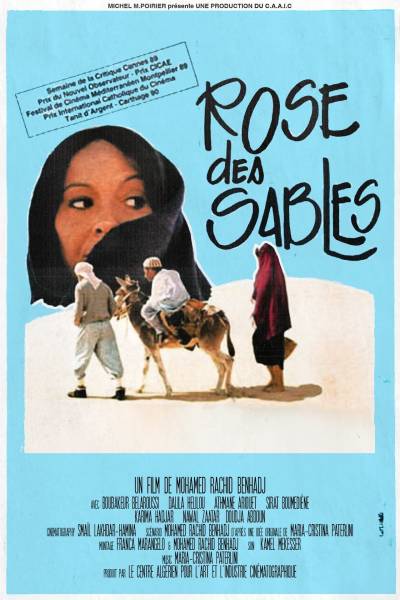 Rose Des SablesLong-métrage – 1989Une oasis perdue dans le désert saharien à plus de 700km d’Alger. Une société fonctionnant encore sur des rituels séculaires. Le seul lien avec la ville est un autobus qui passe u…Smaïl Lakhdar-Hamina est lié(e) à ce film en tant que directeur/trice de la photo
Rose Des SablesLong-métrage – 1989Une oasis perdue dans le désert saharien à plus de 700km d’Alger. Une société fonctionnant encore sur des rituels séculaires. Le seul lien avec la ville est un autobus qui passe u…Smaïl Lakhdar-Hamina est lié(e) à ce film en tant que directeur/trice de la photo -
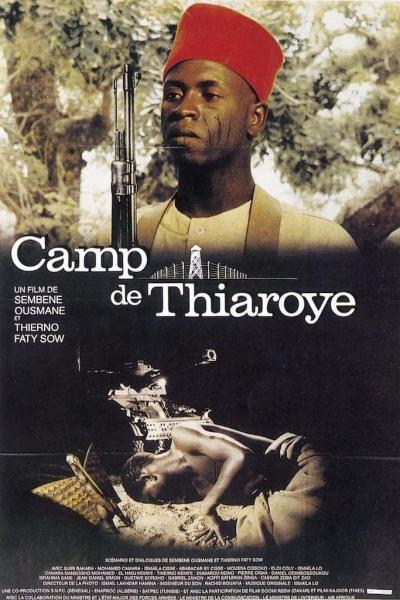 Camp de ThiaroyeLong-métrage – 1988Un épisode sanglant peu glorieux de l’histoire. Au Sénégal en 1944, un bataillon de tirailleurs arrive au camp de transit de Thiaroye, dans la banlieue de Dakar. Ils y attendent leur démobilisation et leur pécule. Après …Smaïl Lakhdar-Hamina est lié(e) à ce film en tant que directeur/trice de la photo
Camp de ThiaroyeLong-métrage – 1988Un épisode sanglant peu glorieux de l’histoire. Au Sénégal en 1944, un bataillon de tirailleurs arrive au camp de transit de Thiaroye, dans la banlieue de Dakar. Ils y attendent leur démobilisation et leur pécule. Après …Smaïl Lakhdar-Hamina est lié(e) à ce film en tant que directeur/trice de la photo -
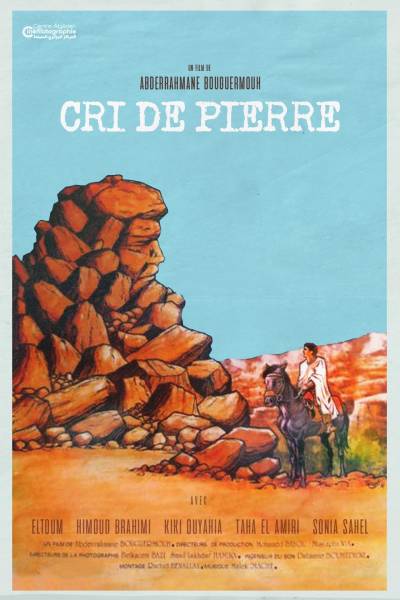 Cri de PierreLong-métrage – 1987"Cris de Pierre" ets un film algérien écrit er réalisé par Abderrahmane Bouguermouh, sorti en 1987. Synopsis Emmené par Daoudi, un architecte désenchanté, …Smaïl Lakhdar-Hamina est lié(e) à ce film en tant que directeur/trice de la photo
Cri de PierreLong-métrage – 1987"Cris de Pierre" ets un film algérien écrit er réalisé par Abderrahmane Bouguermouh, sorti en 1987. Synopsis Emmené par Daoudi, un architecte désenchanté, …Smaïl Lakhdar-Hamina est lié(e) à ce film en tant que directeur/trice de la photo -
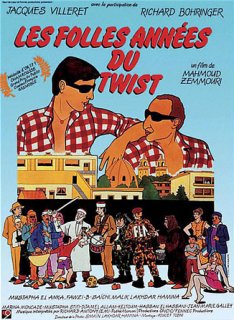 Les Folles Années Du TwistLong-métrage – 1983L'action se déroule dans une petite ville d'Algérie, au cours des années 1960-1962. Mais ce n'est pas un récit sur la guerre, bien que celle-ci en constitue la toile de fond. Nous …Smaïl Lakhdar-Hamina est lié(e) à ce film en tant que directeur/trice de la photo
Les Folles Années Du TwistLong-métrage – 1983L'action se déroule dans une petite ville d'Algérie, au cours des années 1960-1962. Mais ce n'est pas un récit sur la guerre, bien que celle-ci en constitue la toile de fond. Nous …Smaïl Lakhdar-Hamina est lié(e) à ce film en tant que directeur/trice de la photo -
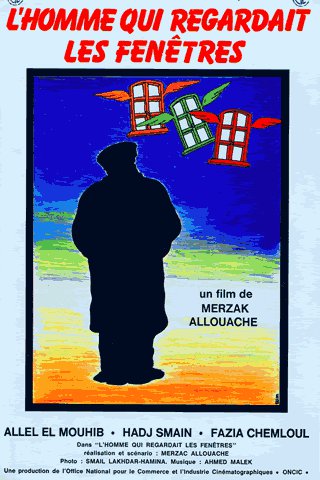 Homme qui regardait les fenêtres (L’)Long-métrage – 1982Interrogé par une voix anonyme, monsieur Rachid, vieux bibliothécaire (spécialiste du cinéma) choqué et déçu par une récente mutation, évoque les derniers instants qui ont précédés la mort tragique d’un de ses collègues….Smaïl Lakhdar-Hamina est lié(e) à ce film en tant que directeur/trice de la photo
Homme qui regardait les fenêtres (L’)Long-métrage – 1982Interrogé par une voix anonyme, monsieur Rachid, vieux bibliothécaire (spécialiste du cinéma) choqué et déçu par une récente mutation, évoque les derniers instants qui ont précédés la mort tragique d’un de ses collègues….Smaïl Lakhdar-Hamina est lié(e) à ce film en tant que directeur/trice de la photo -
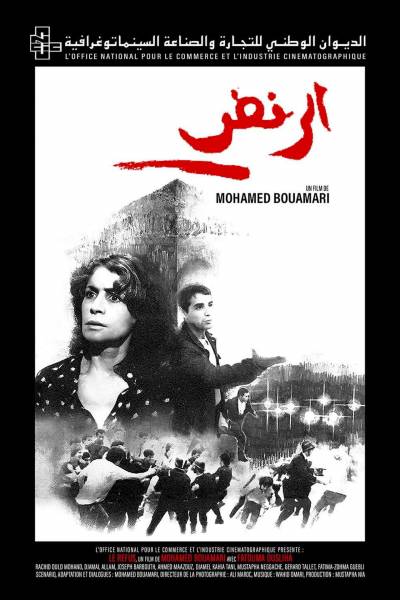 Refus (Le)Long-métrage – 1982Le Refus (الرفض / Al-Raft) est un film algérien de Mohamed Bouamari sorti en 1982 avec Fettouma Ousliha-Bouamari, Djamel Allam, Rachid Ould Mohand, Joël Barbouth, Ahmed Mazouz, Mustapha Negg…Smaïl Lakhdar-Hamina est lié(e) à ce film en tant que directeur/trice de la photo
Refus (Le)Long-métrage – 1982Le Refus (الرفض / Al-Raft) est un film algérien de Mohamed Bouamari sorti en 1982 avec Fettouma Ousliha-Bouamari, Djamel Allam, Rachid Ould Mohand, Joël Barbouth, Ahmed Mazouz, Mustapha Negg…Smaïl Lakhdar-Hamina est lié(e) à ce film en tant que directeur/trice de la photo -
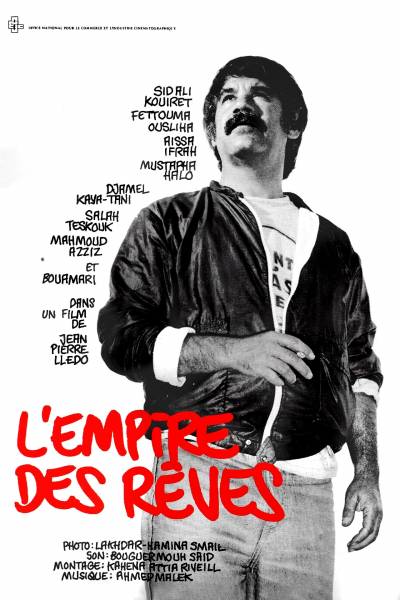 L’Empire Des RêvesLong-métrage – 1982Un réalisateur obstiné qui veut retrouver l'Alger de son enfance, se heurte aux fantasmes "hollywoodiens" de ses personnages, des non-professionnels espérant tous pouvoir devenir "…Smaïl Lakhdar-Hamina est lié(e) à ce film en tant que directeur/trice de la photo
L’Empire Des RêvesLong-métrage – 1982Un réalisateur obstiné qui veut retrouver l'Alger de son enfance, se heurte aux fantasmes "hollywoodiens" de ses personnages, des non-professionnels espérant tous pouvoir devenir "…Smaïl Lakhdar-Hamina est lié(e) à ce film en tant que directeur/trice de la photo -
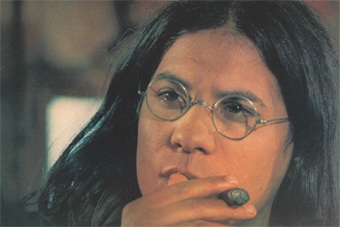 Aventures d’un héros (Les)Long-métrage – 1978Un héros populaire, Mehdi, se promène dans l'histoire en cyclomoteur. Régions et aventures imaginaires défilent au gré de son imagination. Par un subterfuge, Mehdi un jeune paysan e…Smaïl Lakhdar-Hamina est lié(e) à ce film en tant que directeur/trice de la photo
Aventures d’un héros (Les)Long-métrage – 1978Un héros populaire, Mehdi, se promène dans l'histoire en cyclomoteur. Régions et aventures imaginaires défilent au gré de son imagination. Par un subterfuge, Mehdi un jeune paysan e…Smaïl Lakhdar-Hamina est lié(e) à ce film en tant que directeur/trice de la photo -
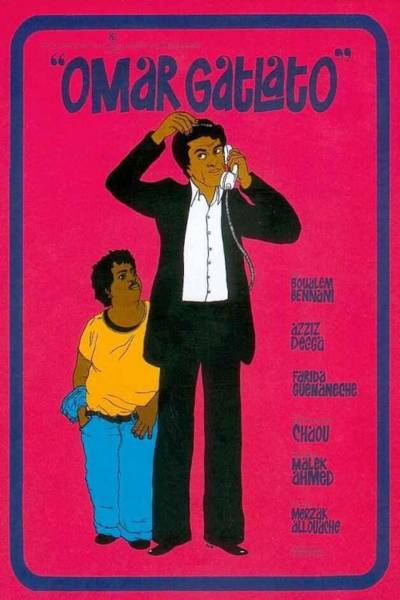 Omar GatlatoLong-métrage – 1976Omar Gatlato (en arabe : عمر قتلتوا الرجلة) est une comédie algérienne de Merzak Allouache sortie en 1977. Synopsis La vie à…Smaïl Lakhdar-Hamina est lié(e) à ce film en tant que directeur/trice de la photo
Omar GatlatoLong-métrage – 1976Omar Gatlato (en arabe : عمر قتلتوا الرجلة) est une comédie algérienne de Merzak Allouache sortie en 1977. Synopsis La vie à…Smaïl Lakhdar-Hamina est lié(e) à ce film en tant que directeur/trice de la photo -
 Hassan TerroLong-métrage – 1968"Hassan Terro" (Comédie-Dramatique) est un film algérien réalisé par Mohamed Lakhdar Hamina en 1968 dont l'acteur Rouiched dans le rôle principal. Synopsis Alors qu&r…Smaïl Lakhdar-Hamina est lié(e) à ce film en tant que directeur/trice de la photo
Hassan TerroLong-métrage – 1968"Hassan Terro" (Comédie-Dramatique) est un film algérien réalisé par Mohamed Lakhdar Hamina en 1968 dont l'acteur Rouiched dans le rôle principal. Synopsis Alors qu&r…Smaïl Lakhdar-Hamina est lié(e) à ce film en tant que directeur/trice de la photo
Partager :



